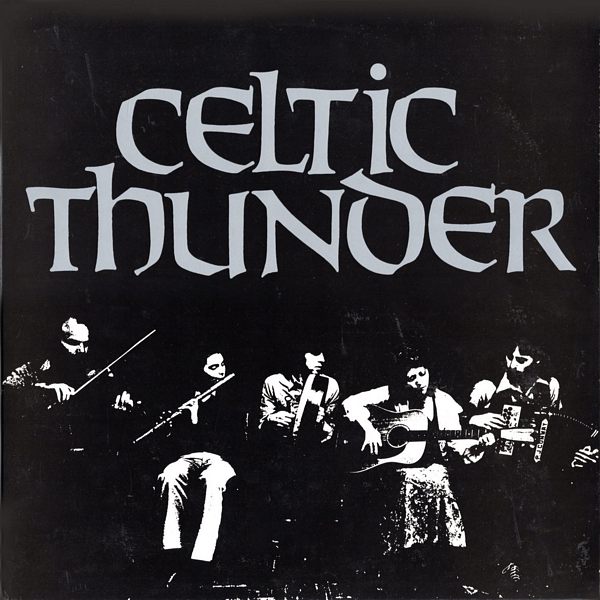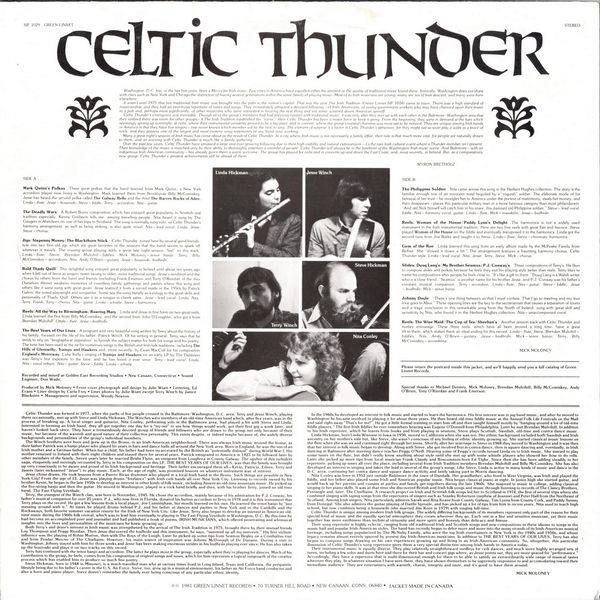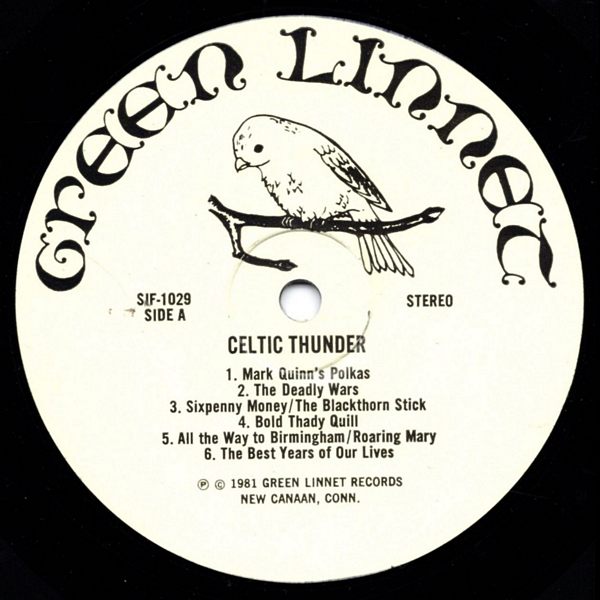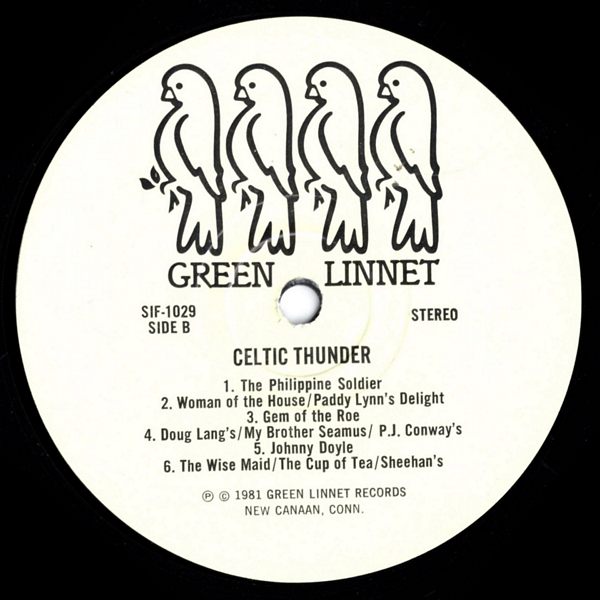
 |


 |
Sleeve Notes
Washington. D.C. has, in the last five years, been a Mecca for Irish music. Few cities in America have equaled either the amount or the quality of traditional music found there. Ironically, Washington does not share with cities such as New York and Chicago the distinction of having several generations within the same family all playing music. Most of its Irish musicians are young, many are not of Irish descent, and many were born elsewhere.
It wasn't until 1975 that live traditional Irish music was brought into the pubs in the nation's capital. That was the year The Irish Tradition (Green Linnet SIF 1016) came to town. Theirs was a high standard of musicianship, and they had an enormous repertoire of tunes and songs. They immediately attracted a devoted following — of Irish-Americans, of young government workers who may have chanced upon their music in a pub and, perhaps most significantly, of other musicians who were interested in hearing the real thing and not some watered-down American spinoff.
Celtic Thunder's emergence was inevitable. Though all of the group's members had had previous contact with traditional music, it was only after they met up with each other in the Baltimore/Washington area that they realized there was room for other groups — if The Irish Tradition established the "scene, " then Celtic Thunder has been a major force to keep it going. From the beginning, they were in demand at the bars which seemingly sprang up overnight: at ceilis, where their instrumental versatility proved to be a big asset: and in concert, where the group's natural charisma was most apt to be noticed. They are unique among Irish bands in America in that they have five singers — one never knows which member will be the next to sing. The element of surprise is a factor in Celtic Thunder's attraction, for they might just as soon play a waltz as a brace of reels, and they possess one of the largest and most esoteric song repertoires of any band now working.
Many a great night's session of Irish music has come about as the result of Celtic Thunder. In a city where Irish music is not necessarily a family affair, their role is that much more vital: for people are naturally drawn to them, and an evening with Celtic Thunder is much like a family gathering.
Over the past few years, Celtic Thunder have amassed a large and ever-growing following due to their high visibility and natural extroversion — it's the rare Irish cultural event where a Thunder member isn't present Their knowledge of the music is matched only by their ability to thoroughly entertain a roomful of people Celtic Thunder will always be in the forefront of the Washington Irish music scene. And Baltimore — with an indigenous Irish-American community — has already given them a warm welcome. The group has played for ceilis and in concerts up and down the East Coast, and, most recently, in Ireland. But, as a comparatively new group, Celtic Thunder's greatest achievements still lie ahead of them.
MYRON BRETHOLZ
Mark Quinn's Polkas: Three great polkas that the band learned from Mark Quinn. a New York accordion player now living in Washington. Mark learned them from Brooklynite Billy McComiskey. Jesse has heard the second polka called The Galway Belle and the third The Barren Rocks of Aden.
Linda: flute; Jesse: bouzouki; Steve: fiddle; Terry: accordion & Nita: guitar
The Deadly Wars: A Robert Burns composition which has enjoyed great popularity in Scottish oral tradition especially. Kenny Goldstein tells me. among travelling people Nita heard it sung by The Gaugers in Aberdeen on one of her trips to Scotland. The song is normally sung solo, so Celtic Thunder's harmony arrangement, as well as being striking, is also quite novel.
Nita: lead vocal & Linda, Jesse & Steve: chorus
Jigs: Sixpenny Money/The Blackthorn Stick: Celtic Thunder, joined here by several good friends. tear into two fine old jigs which are great favorites in the sessions that the band seems to spark off wherever it travels. The rousing group playing adds a great late night session "feel to this track.
Linda: flute; Steve & Brendan Mulvihill: fiddles; Mick Moloney: tenor banjo; Terry & Billy McComiskey: accordions; Nita & Andy O'Brien: guitars & Jesse: bouzouki & bodhrán
Bold Thady Quill: This delightful song enjoyed great popularity in Ireland until about ten years ago when it fell out of favor as singers' tastes swung to older, more traditional songs. Jesse's rendition and the chorus by others from the band and friends (including Frank Emerson and Tony O'Riordan of the duo Ourselves Alone) awakens memories of countless family gatherings and parties where this song and others like it were sung with great gusto. Jesse learned it from a record made in the 1950s by Patrick Galvin, the noted playwright and songwriter. Some see the song literally as a eulogy to the great skills and personality of Thady Quill Others see it as a tongue-in-cheek satire.
Jesse: lead vocal; Linda, Nita, Terry, Frank & Tony: chorus; Nita: guitar; Linda: whistle & Steve: harmonica
Reels: All the Way to Birmingham/ Roaring Mary: Linda and Jesse in fine form on two great reels Linda learned the first from Billy McComiskey. and the second from John O'Loughlin. who got it from Brendan Mulvihill.
Linda-flute & Jesse: bodhrán
The Best Years of Our Lives: A poignant and very beautiful song written by Terry about the history of his family, focused on the life of his father. Patrick Winch. Of his writing in general. Terry says that he tends to rely on "biographical inspiration" to furnish the subject matter for both his songs and his poetry. The tune has been used as the air for numerous songs in the British and Irish folk traditions, including The Hills of Glenswilly, Tramps and Hawkers and. more recently, by Ewan MacCoIl for his composition England's Motorway. Luke Kelly's singing of Tramps and Hawkers on an early LP by The Dubliners was Terry's first exposure to the tune, and he has loved it ever since.
Terry: lead vocal; Linda & Nita- vocal refrain; Nita: guitar; Steve: fiddle & Linda: whistle
The Philippine Soldier: Nita came across this song in the Herbert Hughes collection The story is the familiar enough one of an innocent maid beguiled by a "roguish" soldier. The elaborate mode of his betrayal of her trust — he inveigles her to America under the pretext of matrimony, steals her money, and then disappears — places this particular military man in a more heinous category than most philanderers. "And old Nick himself will catch him in his snare, this damned old Philippine soldier."
Steve: lead vocal & fiddle; Nita: harmony vocal & guitar; Linda: flute; Mick: mandolin & Jesse: bodhrán.
Reels: Woman of the House/Paddy Lynn's Delight: The harmonica is not a widely used instrument in the Irish instrumental tradition. Here are two fine reels with great flair and bounce. Steve played Woman of the House on the fiddle and eventually transposed it to the harmonica. Linda got the second tune from Joe Burke and taught it to Steve.
Linda: flute & Steve: chromatic harmonica
Gem of the Roe: Linda learned this song from an early album made by the McPeake Family from Belfast She "slowed it down a bit." The arrangement features a haunting harmony chorus. Celtic Thunder style.
Linda: lead vocal & Nita, Jesse, Terry, Steve & Mick: chorus
Slides: Doug Lang's/My Brother Seamus/P.J. Conway's: Three compositions of Terry's. He likes to compose slides and polkas because he feels they suit his playing style better than reels. Terry likes to name his compositions after people he feels close to. "It's like a gift to them." Doug Lang is a Welsh writer who is a close friend "Seamus is another name for his brother Jesse, and P.J. Conway was his father's constant musical companion.
Terry: accordion; Linda: flute; Nita: guitar; Steve: fiddle; Jesse: bodhrán & Mick: tenor banjo
Johnny Doyle: "There's one thing between us that I must confess: That I go to meeting and my true love goes to Mass." These opening lines are the key to the sectarianism that causes a separation of lovers and a tragic conclusion in this remarkable song from the North of Ireland, sung with great skill and sensitivity by Nita. who found it in the Herbert Hughes collection.
Nita: unaccompanied vocal
Reels: The Wise Maid/The Cup of Tea/Sheehan's: Another session track with Celtic Thunder and motley entourage These three reels, which have all been around a long time, have a great lift to them, which makes them an ideal ending for this record.
Linda: flute; Steve. Brendan Mulvihill: fiddles; Nita & Andy O'Brien: guitars; Jesse: bodhrán; Mick: tenor banjo & Terry & Billy McComiskey: accordions
Celtic Thunder was formed in 1977, when the paths of five people crossed in the Baltimore/Washington, D.C. area. Terry and Jesse Winch, playing there occasionally, met up with Steve and Linda Hickman. The Winches were members of an old-time American band which, after five years, was in the process of breaking up. A local singer and guitarist, Nita Conley, performing solo in the Baltimore area, had played a bit with Steve and Linda. Interested in forming an Irish band, they all got together one day for a "try-out" to see how things would work, got their first gig a week later, and haven't looked back since. They have a tremendously devoted group of friends and followers who are drawn to the group not only because of their music, but because of the warmth and good nature of their collective personality. This exists despite, or indeed maybe because of, the widely diverse backgrounds and personalities of the group's individual members.
The Winch brothers were born and grew up in the Bronx, in an Irish-American neighborhood. There was always Irish music around the house, as their father Patrick was a banjo player who played for years in bars and dance halls all around the New York area. Born in England, he was the son of an Irish mother and a German father. When but a child, his father had been incarcerated by the British as "potentially disloyal" during World War I. His mother returned to Ireland with their eight children and stayed there for several years. Patrick emigrated to America in 1923 to be followed later by other members of the family. Seven years later he married Bridie Flynn, an emigrant from Loughrea in County Galway. The upshot of this turbulent saga, eloquently and movingly recounted by Terry in his composition on this LP, THE BEST YEARS OF OUR LIVES, was that the family was brought up very consciously to be aware and proud of its Irish background and heritage. Their father encouraged them all — Kevin, Patricia, Eileen. Terry and James (later nicknamed "Jesse") to play music. Each, at the age of eight, was promised lessons on whatever instrument was of interest.
Jesse chose drums. He took lessons from a Puerto Rican drummer who played in a local Irish band in the Bronx. Such things are possible in New-York City! From the age of 13, Jesse was playing drums "freelance" with Irish ceili bands all over New York City. Listening to records owned by his brother Kevin, he began in the late 1950s to develop an interest in other kinds of folk music, including American old-time mountain music. He picked up the five-string banjo and then the guitar. He moved to Washington, played in a rock band briefly and then, with his brother Terry, joined an old-time band. The Fast Flying Vestibule.
Terry, the youngest of the Winch clan, was born in November, 1945. He chose the accordion, mainly because of his admiration for P.J. Conway, his father's musical companion for over 25 years. P.J., who now lives in Florida, donated his button accordion to Terry in 1978 and it is this instrument that Terry plays on the record. He got a few lessons from a local player, Joe Cunningham, but mostly learned on his own. He learned the tenor banjo by "just messing around with it." At times he played drums behind P.J. and his father at dances and parties in New York and in the Catskills and the Rockaways, both favorite summer vacation resorts for the Irish of New York City. Like Jesse, Terry also began to develop an interest in American old-time music during the 1960s folk revival, which was to lead him eventually to playing in The Fast Flying Vestibule in Washington. D.C. By this time he had become an accomplished poet and journalist and had published a book of poems, IRISH MUSICIANS, which offered penetrating and whimsical insights into the lives and personalities of the musicians he knew growing up.
Both Terry's and Jesse's interest in Irish music was strengthened by the arrival of The Irish Tradition in 1975, brought there by their mutual friends Lou Thompson and Peggy Riordan. Then Jesse discovered the bodhrán and this instrument, he says, "summed up all my interests." His first stylistic influence was the playing of Robin Morton, then with The Boys of the Lough. Later he picked up some tips from Seamus Begley on a Comhaltas tour and from Peadar Mercier of The Chieftains. However, his main source of inspiration was Johnny McDonagh of De Danann. During a visit to Washington. Johnny stayed with him for three weeks and Jesse has been making enormous strides in his bodhrán playing ever since. He has also taken up the bouzouki and plays it on two tracks on this record.
Terry has continued with the tenor banjo and accordion. The latter he plays most in the group, especially when they're playing for dances. Much of his contribution to the group, he feels, comes from his composition of original songs and tunes, which for him represents a logical outgrowth of the creative process which has enabled him to produce so much fine poetry.
Steve Hickman, born in 1948 in Missouri, is a much-travelled man who at various times lived in Long Island, Texas and California, the peripatetic lifestyle being due to his father's career in the U.S. Air Force. Steve, too, grew up in a musical environment, his father an Air Force band conductor and also a horn and piano player. Steve doesn't remember the family ever being conscious of any particular ethnic identity.
In the 1960s he developed an interest In folk music and started to learn the harmonica. His first interest was in Jug band music, and after he moved to Washington he became involved in playing it for about three years. He then heard old-time fiddle music at the Annual Folk Life Festivals on the Mall and said right away "That's for me!". He got a little formal training to start him off and then taught himself mostly by "hanging around ft lot of old-lime fiddle players." The first Irish fiddler he ever remembers hearing was Eugene O'Donnell from Philadelphia. Later he met Brendan Mulvlhlll. In addition to his Irish repertoire, which he learns from books and from playing in sessions, Steve plays Scottish, Swedish, old-time and contra dance music.
Linda Hickman, born Linda Wisnane in Iowa in 1950, moved to California when she was ten. Her ethnic background Included both Swedish and Irish ancestry on her mother's side but, like Steve, she wasn't conscious of any feeling of ethnic identity growing up. She started classical music lessons on the flute when she was six and continued right through her teens. Shortly after her marriage to Steve in 1968 they moved to Washington and it was then that her interest in folk music began to develop. Along with Steve, she got involved first in contra dance, then in square dancing and, eventually, in Irish dancing in Baltimore after meeting dance teacher Peggy O'Neill. Hearing some of Peggy's records turned Linda on to Irish music. She started to play some tunes on the flute, but didn't really know anything about style until she met up with some whistle players who showed her how to do rolls. Later she picked up more tips from local musician Frank Claudy and Roscommon-born Ed Tighe. Since then she has been adding steadily to her repertoire, picking up tunes all over the place, including several from Irish Tradition members Brendan Mulvihill and Billy MoComiskey. She has also developed an interest in singing and takes the lead in several of the group's songs. Like Steve, Linda is active in many kinds of music and dance In the D.C. area, continuing her contra dance and square dance activity and lately taking part in Morris dancing.
Nita Conley was born in 1952 just outside Baltimore in the town of Dundalk. Her grandfather, who lived in West Virginia, was Irish and played the fiddle, and her father also played some Irish and American popular music. Nita began classical piano at eight. In junior high she started guitar, and would back up her parents and cousins at parties and family get-togethers during the late 1960s. She majored in music in college, adding classical singing to her piano skills. It was at that time she discovered British and Irish folk songs and music through listening to records of The Clancy Brothers, Pentangle and, later, The Chieftains. A research project on Irish and Scottish folk songs led her to Scotland in 1974, the first of several trips where she combined singing with taping songs from the repertoires of singers such as Stanley Robertson (nephew of Jeannie) and Peter Hall from the Northeast of Scotland. Among Irish singers, Nita particularly admires Sarah and Rita Keane from County Galway, Tim Lyons from County Cork, and Paddy Tunney from Donegal. She also admires the guitar playing of Daithi Sproule, and has picked up a lot of lips from him in recent years. Nita used to teach high school, but now combines being a housewife (she married Jim Korn in 1979) with singing full-time.
Celtic Thunder is unique among modern Irish folk groups. The widely differing backgrounds of its members represent only part of the reason for their special kind of music and the equally special atmosphere they create wherever they go. Each one is a fine and sensitive musician, yet their music together has more earthiness than technical virtuosity and more spirit and honesty than delicacy and finesse.
Their song repertoire is highly eclectic, ranging from old traditional Irish and Scottish songs and new compositions in these idioms to songs In the music hall and popular Irish-American styles. The band has recently begun to delve more and more into the many strands of its Irish-American musical heritage, including songs popularized by The McNulty Family, who were the top Irish entertainers in New York in the 1940s and 1950s, and whose legacy remains almost entirely ignored by present day Irish-American musicians. In addition to THE BEST YEARS OF OUR LIVES, Terry has also begun to compose songs drawing on his own experiences growing up and living in an Irish-American community. So, altogether, this particular dimension of Celtic Thunder's song repertoire gives them a very special distinction among Irish bands in America today.
Their instrumental music is equally diverse. They play relatively straightforward medleys for ceili dances, and much more highly arranged sets of tunes, including a few solos and duets here and there for their bar and concert gigs where, as Jesse points out, they are more geared for "performance." Accordingly, they have a repertoire that is multi-dimensional enough for them to be able to satisfy an extraordinarily wide range of musical tastes wherever they play. In whatever situation I have seen them, they have shown themselves to be supremely responsive to and accommodating toward their immediate audience. They are entertainers with warmth, charm, integrity and taste, and it's good to have them around.
MICK MOLONEY